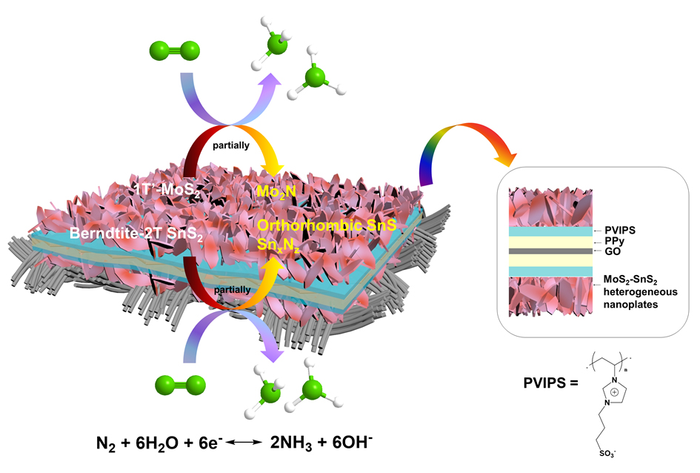Ammonia (NH3) as a very important chemical feedstock, is widely used for synthesizing various chemical products in modern industrial production. However, the traditional Haber-Bosch process for reducing N2 to produce NH3 not only needs to be operated under harsh synthetic conditions, but also brings huge fossil energy consumption and serious environmental pollution. The electrochemical nitrogen reduction reaction (NRR) under ambient conditions has been considered as a most promising sustainable clean energy technology for the production of NH3, whose essential core for practical application is focused on exploring the NRR electrocatalysts with high efficiency, low cost and easy preparation.

Credit: Chinese Journal of Catalysis
Ammonia (NH3) as a very important chemical feedstock, is widely used for synthesizing various chemical products in modern industrial production. However, the traditional Haber-Bosch process for reducing N2 to produce NH3 not only needs to be operated under harsh synthetic conditions, but also brings huge fossil energy consumption and serious environmental pollution. The electrochemical nitrogen reduction reaction (NRR) under ambient conditions has been considered as a most promising sustainable clean energy technology for the production of NH3, whose essential core for practical application is focused on exploring the NRR electrocatalysts with high efficiency, low cost and easy preparation.
Transition metal dichalcogenides (TMDCs) with abundant reserves and low cost present outstanding electrocatalytic activity due to its polytropic crystal structures and phase compositions, controllable morphologies, adjustable defect engineering, which have been selected as the ideal alternative for replacing precious metals. Therefore, it is of great significance for effectively regulating TMDCs structure to improve its electrocatalytic NRR activity.
Recently, a research team led by Prof. Tianyi Ma from RMIT University (Australia) and Prof. Xi-Ming Song from Liaoning University (China) reported the inorganic/organic hierarchical nanostructures used for electrocatalytic NRR, where the unique MoS2-SnS2 heterogeneous nanoplates have in-situ grown on poly(3-(1-vinylimidazolium-3-yl)propane-1-sulfonate) (PVIPS) functionalized polypyrrole/graphene oxide (PPy/GO) by the interfacial induced effect. The obtained MoS2-SnS2/PVIPS/PPy/GO can serve as electrocatalysts, exhibiting good NRR performance by the synergistic effect. The semi-conducting SnS2 would limit the surface electron accessibility for suppressing HER process of 1T’-MoS2, while metallic 1T’-MoS2 might efficiently improve the NRR electroactivity of SnS2 by the creation of Mo–Sn–Sn trimer catalytic sites. Otherwise, the irreversible crystal phase transition has taken place during the NRR process. Partial 1T’-MoS2 and SnS2 have electrochemically reacted with N2, and irreversibly converted into Mo2N and SnxNz due to the formation of Mo−N and Sn−N bonding. Meanwhile, partial SnS2 has been irreversibly evolved into SnS due to the reduction by the power source in the electrochemical system. The results were published in Chinese Journal of Catalysis (https://doi.org/10.1016/S1872-2067(21)63944-X).
###
About the Journal
Chinese Journal of Catalysis is co-sponsored by Dalian Institute of Chemical Physics, Chinese Academy of Sciences and Chinese Chemical Society, and it is currently published by Elsevier group. This monthly journal publishes in English timely contributions of original and rigorously reviewed manuscripts covering all areas of catalysis. The journal publishes Reviews, Accounts, Communications, Articles, Highlights, Perspectives, and Viewpoints of highly scientific values that help understanding and defining of new concepts in both fundamental issues and practical applications of catalysis. Chinese Journal of Catalysis ranks among the top six journals in Applied Chemistry with a current SCI impact factor of 8.271. The Editors-in-Chief are Profs. Can Li and Tao Zhang.
At Elsevier http://www.journals.elsevier.com/chinese-journal-of-catalysis
Manuscript submission https://mc03.manuscriptcentral.com/cjcatal




